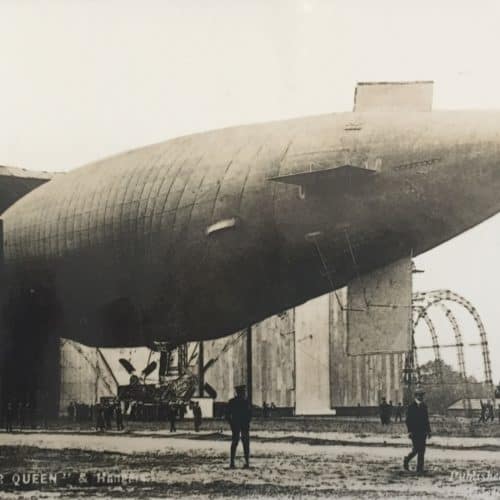WW1 activity 10: design a new airship or zeppelin for RNAS Capel le Ferne
Overview
Did you know Zeppelins tried to bomb Folkestone? And that there was a British airship station on the cliffs at Capel Le Ferne? Children investigate the history, science and technology of these air-bourne giants, before building their own working prototype in fun lighter than air experiment.
Learning objectives
Increased knowledge and understanding of the WW1 war in the air. In particular the airships at RNAS Capel Le Ferne designed to spot German U-boats in the English Channel. And attacks on the UK and Folkestone by German Zeppelins.
Learning about gases, and that some like hydrogen and helium are lighter than air and cause objects to rise. Learning that some gases are inert (non-reactive) and others explosive. Learning that WW1 airships and airships today use lighter than air gases to fly.
Developing skills and confidence in science and design technology, by experimentation including making a working airship.
That science is fun and a possible future career for girls as well as boys.
Curriculum links
KS1-2 History (WW1)
KS1-2 Science (investigating materials, gases and their properties)
KS1-2 Maths (measuring, recording data in a table or graph)
KS1-2 Design technology (design and built a working model WW1 airship using helium balloons)
The children explore Learn with Objects WW1 16: Zeppelins and airships to find out about German and British airships in WW1.
This might include research on Zeppelin raids on Britain, including on Folkestone, as well as the WW1 Royal Navy Air Station on the cliffs at Capel Le Ferne. Different groups could research each subject and report back.
The BBC Teach web link (see below) is also very useful and includes WW1 archive film footage of Zeppelins, and of the shooting down of the Cuffley Zeppelin, a small relic of which is in the Folkestone Museum collection.
It also gives some good ideas for exploring WW1 Zeppelins with your class at KS1-2 level and a helium airship lifting experiment.
https://www.bbc.co.uk/teach/class-clips-video/z-is-for-zeppelins/z7rvrj6
Design an airship
The class are set the challenge of building a new airship to replace the outdated pre-WW1 Silver Queen airship which has been badly damaged after hitting a cable (and wasn’t very good anyway). The new airship has to meet the following criteria.
- Be able to fly at a stable height in the sky above the English Channel to spot U-boats
- Carry a crew of three (one to fly it, one to navigate it and one to act as spotter)
- Have a means of power and steering (on the blueprint at least!)
- Have a means of signalling with the ground
Working in teams, children create a blueprint of their TOP SECRET design. They also need to give their new airship a name. Allow 20 minutes for this.
Then using the following materials create a working prototype to take part in a Lift and Stability Trial.
- helium party balloons (suggest 3 per group)
- bin bags
- reel of cotton thread
- sticky tape
- wire
- thin garden sticks (the ones used to support small plants
- coins or metal washers
Teams have to prove to the Boffins that their new prototype airship has a rigid and stable structure, can safely lift 3 people (Lego mini figures into the air) and be adjusted to fly at a stable height. The children need to think of a way to achieve this? By adding and taking away weights perhaps?
They also need to record in a table or graph the results of their experiments.
Allow 30 minutes for building. With an extra 30 minutes at the end for each team to demonstrate their working design in turn to the whole class and to discuss what worked well, what didn’t and why.
More ambitious flyers may like to include a means of propulsion, a lightweight motor and propeller unit from a small radio-controlled aeroplane perhaps, or from an elastic band powered balsa model plane.
Learn with Objects links
Use Learn with Objects WW1 16: Zeppelins and airships for info and images.

